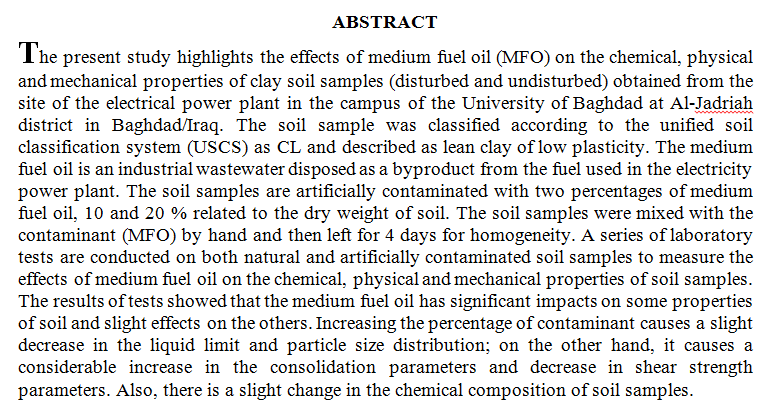
This paper presents the thermophysical properties of zinc oxide nanofluid that have been measured for experimental investigation. The main contribution of this study is to define the heat transfer characteristics of nanofluids. The measuring of these properties was carried out within a range of temperatures from 25 °C to 45 °C, volume fraction from 1 to 2 %, and the average nanoparticle diameter size is 25 nm, and the base fluid is water. The thermophysical properties, including viscosity and thermal conductivity, were measured by using Brookfield rotational Viscometer and Thermal Properties Analyzer, respectively. The result indicates that the thermophysical properties of zinc oxide nanofluid increasing with nanoparticle volume f
... Show More (1)
(1)
 (1)
(1)
he paper presents the results of exposure of normal concrete to high temperatures (400 and 700°C). In addition to the exposure of steel reinforcement bar Ø 12 mm, where two types of steel reinforcement burning situations were performed. Directly exposed to high temperatures (400 and 700°C) and others were covered by concrete layer (15 mm). From the experimental results of fire exposure for 1 hour of 400 and 700°C and gradually cooled, it was found that the residual average percentage of compressive strength of concrete was 85.3 and 41.4%, while the residual average percentage of modulus of elasticity of concrete was 75 and 48%, respectively. The residual average percentage of yielding tensile stress (Ø 12 mm) after burning and cooling
... Show More (5)
(5)
 (4)
(4)
The goal of our study is to perform detailed multiband surface photometry of the spiral galaxy NGC 4448 and its brightest star-forming regions. The structure and composition of the stellar population in the surface brightness galaxy NGC 4448 was studied using BVR CCD photometry. The observations were obtained on the 1.88 m optical telescope of Kottamia Astronomical Observatory (KAO), Egypt. A two-dimensional decomposition of the galaxy bulge and disk components is carried out. A powerful star forming region is observed near the galactic center. Based on the positions of the various components of the galaxy in two color diagrams. From the observations, the surface brightness profiles, Ellipticity profiles, position angle profiles and colo
... Show MoreThe δ-mixing ratios have been calculated for several γ-transitions in 90Mo using the 𝛔 𝐉 method. The results are compared with other references the agreement is found to be very good .this confirms the validity of the 𝛔 𝐉 method as a tool for analyzing the angular distribution of γ-ray. Key word: population parameter, γ-ray transition, 𝛔 𝐉 method, multiple mixing ratios.
structural and electrical of CuIn (Sex Te1-x)2
A nanocrystalline thin films of PbS with different thickness (400, 600)nm have been prepared successfully by chemical bath deposition technique on glass and Si substrates. The structure and morphology of these films were studied by X-ray diffraction and atomic force microscope. It shows that the structure is polycrystalline and the average crystallite size has been measured. The electrical properties of these films have been studied, it was observed that D.C conductivity at room temperature increases with the increase of thickness, From Hall measurements the conductivity for all samples of PbS films is p-type. Carrier's concentration, mobility and drift velocity increases with increasing of thickness. Also p-PbS/n-Si heterojunction has been
... Show MoreIn this study three inorganic nano additives, namely; CaCO3, Al2O3 and SiO2 were used to prepare nanocomposites of unsaturated polyester in order to modify their mechanical properties, i.e. tensile strength, elongation, impact and hardness. The results indicated that all the three additives were effective to improve the mechanical properties up to 4% by weight. The effectiveness of them follows the order : CaCO3 > Al2O3 > SiO2 This is due to their particle size in which CaCO3 (13nm), Al2O3 (20-30nm) and SiO2 (15-20nm).
Background: This study aimed to compare the mechanical properties between four groups of newly fabricated combination wires according to their method of union, according to the gauges of wires and a comparison were made between them and their originals. Materials and method: A total of 60 stainless steel combination wires were fabricated , divided into four groups according to gauge of wires and their method of union, each of them with 15 samples, the groups were welded (0.016x0.022-0.016 and 0.016x0.022-0.018) and soldered (0.016x0.022-0.016 and 0.016x0.022-0.018), samples were made according to certain parameters which were : for the welded samples: length,weight, duration of pulsation and size of copper electrode tips used; for the sold
... Show MoreIn the current study, the definition of mapping of fuzzy neutrosophic generalized semi-continuous and fuzzy neutrosophic alpha has generalized mapping as continuous. The study confirmed some theorems regarding such a concept. In the following, it has been found relationships among fuzzy neutrosophic alpha generalized mapping as continuous, fuzzy neutrosophic mapping as continuous, fuzzy neutrosophic alpha mapping as continuous, fuzzy neutrosophic generalized semi mapping as continuous, fuzzy neutrosophic pre mapping as continuous and fuzzy neutrosophic γ mapping as continuous.
 (1)
(1)
In this research a study of the effect of quality, sequential and directional layers for three types of fibers are:(Kevlar fibers-49 woven roving and E- glass fiber woven roving and random) on the fatigue property using epoxy as matrix. The test specimens were prepared by hand lay-up method the epoxy resin used as a matrix type (Quick mast 105) in prepared material composit . Sinusoidal wave which is formed of variable stress amplitudes at 15 Hz cycles was employed in the fatigue test ( 10 mm )and (15mm) value 0f deflection arrival to numbers of cycle failure limit, by rotary bending method by ( S-N) curves this curves has been determined ( life , limit and fa
... Show More